 In India, unemployment is also at record highs. Youth comprise more than 10% of the unemployed in India, and almost 20% in Kenya and Nigeria. These rates tend to be even higher in rural communities. As this challenge of “jobless growth” worsens, another challenge persists: that nearly 1 billion people, mostly living in the countryside in Africa and Asia, still live in energy poverty, with no access to electricity.
In India, unemployment is also at record highs. Youth comprise more than 10% of the unemployed in India, and almost 20% in Kenya and Nigeria. These rates tend to be even higher in rural communities. As this challenge of “jobless growth” worsens, another challenge persists: that nearly 1 billion people, mostly living in the countryside in Africa and Asia, still live in energy poverty, with no access to electricity.
New census data released today on World Youth Skills Day, however, shows that delivering rural electrification using distributed renewable energy (DRE) can also put a serious dent in joblessness, in particular for youth and women. The data was contained in the first annual Powering Jobs Census, released by international NGO Power for All and its research partners.
According to the census, decentralized renewable energy solutions – including mini-grids, solar for households and businesses, and systems to power machinery such as irrigation pumps and other appliances – already employ as many people as the traditional utility power sector in the three countries surveyed – India, Kenya and Nigeria.
For example, in Kenya, decentralized renewable energy companies directly employ 10,000 formal workers . And that number is expected to grow 70% by 2022-23. By comparison, the state utility, KPLC, employs 11,000 today.
In Nigeria, direct employment by the sector is expected to boom more than 10-fold by 2022-23 to 52,000 jobs.
The census found that these jobs are mostly skilled, long-term and middle-income, which is hard to find in a job market today that is increasingly dominated by informal workers.
In this regard, the decentralized renewable energy sector is also performing well, creating double the number of informal jobs compared to formal jobs, and expanding rapidly.
Source: Forbes












